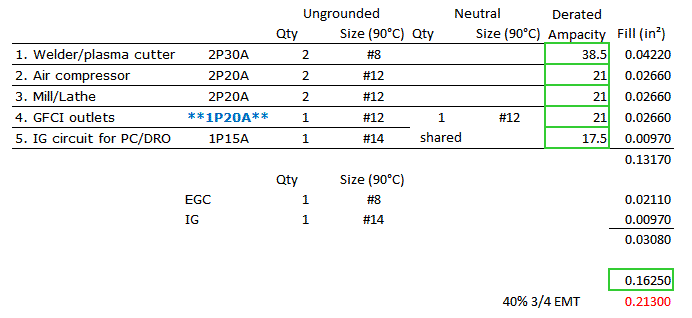I am installing new wiring in EMT conduit for a garage workshop. The workshop needs power for the following circuits:
1. Welder/plasma cutter (230V / 30A max)
2. Air compressor (230V / 15A)
3. Mill/Lathe (230V / 15A max)
4. GFCI outlets (115V / 20A max)
5. Isolated ground circuit for PC/DRO (115V / 15A max)
I was designing the branch circuits as follows (to match the loads above):
1. 30A breaker; 2 #10 hots + 1 #10 ECG
2. 20A breaker; 2 #12 hots (EMT for ECG)
3. 20A breaker; 2 #12 hots (EMT for ECG)
4. 15A breaker; 1 #12 hot + 1 #12 neutral (EMT for ECG)
5. 15A breaker; 1 #14 hot + 1 #14 neutral + 1 #14 ECG
My fill calculations specify a 3/4" EMT raceway @40% fill (downsized to 1/2" EMT as the branches split off).
But my problem comes to derating as it would appear that I have 10 current-carrying conductors. At 9 conductors (70% derating) I would be fine. But at 10 conductors (50% derating), everything is too small. Of course, I'm trying to avoid up-sizing everything.
If it helps, there would never be a time when all circuits are in use simultaneously. For example, the welder circuit would never be in use at the same time as the mill/lathe circuit. Also, most of the circuits will draw less current than I've specified. I've sized the branch circuit ampacities to allow for in-rush current and possible future increases (which is why I specified "max" on all the circuits except the air compressor which actually is rated at 15A).
Any recommendations or suggestions to save me?
1. Welder/plasma cutter (230V / 30A max)
2. Air compressor (230V / 15A)
3. Mill/Lathe (230V / 15A max)
4. GFCI outlets (115V / 20A max)
5. Isolated ground circuit for PC/DRO (115V / 15A max)
I was designing the branch circuits as follows (to match the loads above):
1. 30A breaker; 2 #10 hots + 1 #10 ECG
2. 20A breaker; 2 #12 hots (EMT for ECG)
3. 20A breaker; 2 #12 hots (EMT for ECG)
4. 15A breaker; 1 #12 hot + 1 #12 neutral (EMT for ECG)
5. 15A breaker; 1 #14 hot + 1 #14 neutral + 1 #14 ECG
My fill calculations specify a 3/4" EMT raceway @40% fill (downsized to 1/2" EMT as the branches split off).
But my problem comes to derating as it would appear that I have 10 current-carrying conductors. At 9 conductors (70% derating) I would be fine. But at 10 conductors (50% derating), everything is too small. Of course, I'm trying to avoid up-sizing everything.
If it helps, there would never be a time when all circuits are in use simultaneously. For example, the welder circuit would never be in use at the same time as the mill/lathe circuit. Also, most of the circuits will draw less current than I've specified. I've sized the branch circuit ampacities to allow for in-rush current and possible future increases (which is why I specified "max" on all the circuits except the air compressor which actually is rated at 15A).
Any recommendations or suggestions to save me?


